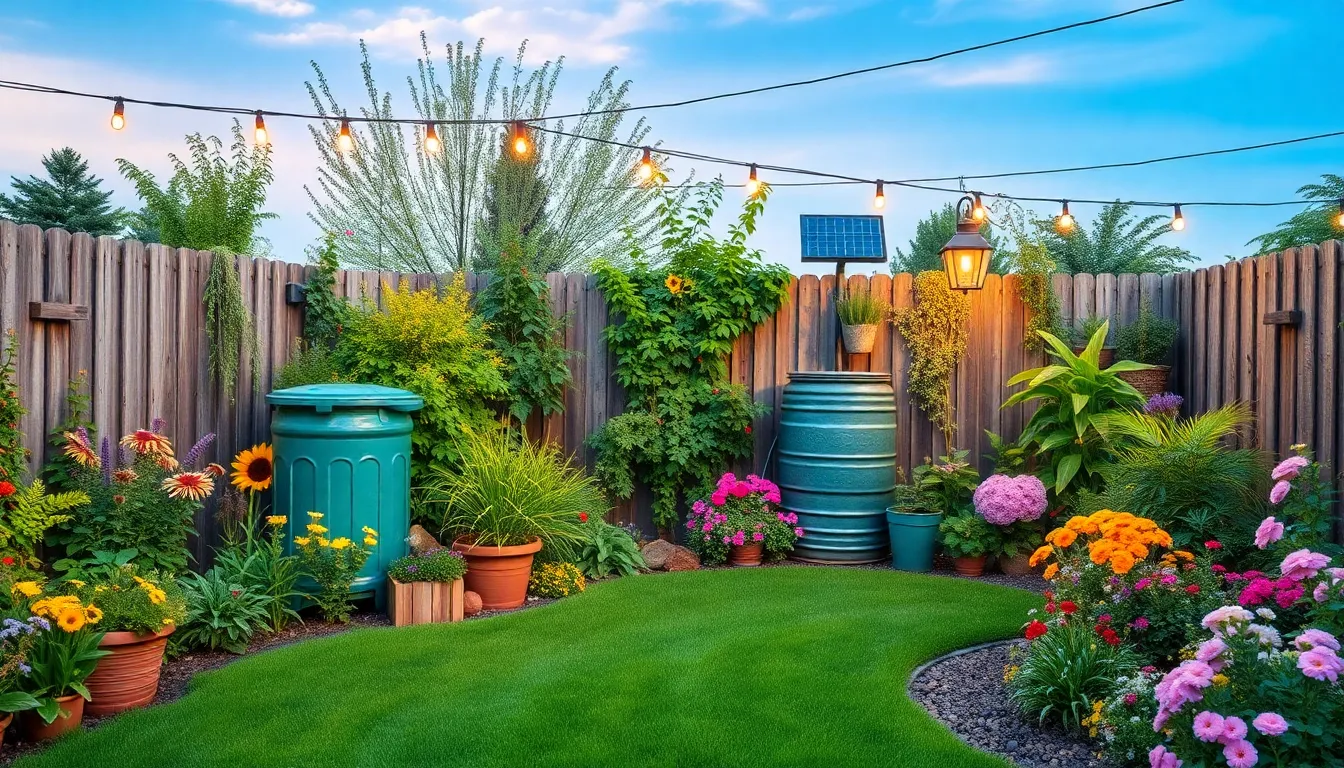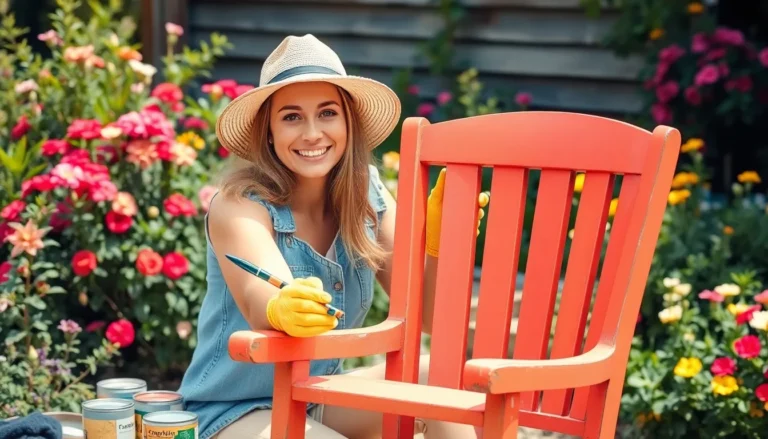Imagine stepping into your backyard paradise, where vibrant flowers bloom, birds sing, and the only thing greener than your grass is your commitment to the planet. An eco-friendly backyard isn’t just a trend; it’s a lifestyle choice that transforms outdoor spaces into sustainable sanctuaries. With a sprinkle of creativity and a dash of commitment, anyone can turn their patch of earth into an environmental haven.
Table of Contents
ToggleWhat Is an Eco-friendly Backyard?
An eco-friendly backyard serves as a sustainable outdoor space designed to benefit the environment. It incorporates elements that support biodiversity, conserving resources while enhancing the natural habitat. Native plants contribute to local ecosystems also providing food and shelter for wildlife.
Water conservation plays a crucial role in eco-friendly backyards. Installing rain barrels captures rainwater, while drip irrigation systems deliver moisture directly to plant roots. Compost bins transform kitchen scraps into nutrient-rich soil, promoting healthy plant growth.
Creating habitats for beneficial insects and pollinators enhances an eco-friendly backyard. Features like birdhouses and insect hotels attract essential species, supporting the ecosystem’s balance. Additionally, organic gardening practices minimize chemical use, ensuring soil health and producing chemical-free vegetables.
Maintaining an eco-friendly backyard involves thoughtful landscaping choices. Selecting drought-tolerant plants reduces water usage, and implementing mulch helps retain soil moisture. Pathways made from reclaimed materials prevent soil erosion and reduce environmental impact.
Incorporating renewable energy sources can further enhance sustainability. Solar lights illuminate pathways without consuming electricity from nonrenewable resources. Utilizing eco-friendly furniture made from sustainable materials creates inviting outdoor spaces while reducing carbon footprints.
Overall, an eco-friendly backyard reflects a commitment to environmental stewardship. It combines creativity with practicality, creating an outdoor oasis that nurtures nature. Prioritizing sustainability and biodiversity cultivates beauty while supporting a healthier planet.
Benefits of an Eco-friendly Backyard

An eco-friendly backyard offers numerous advantages for both the environment and human health.
Environmental Impact
Creating a sustainable backyard significantly enhances local biodiversity. Native plants attract various pollinators such as bees and butterflies, fostering healthy ecosystems. Water conservation methods like rain barrels reduce reliance on municipal water supplies, promoting sustainable usage. Composting organic waste enriches soil, minimizing landfill contribution and supporting plant growth. Implementing renewable energy sources, like solar-powered lights, reduces carbon footprints. Thoughtfully designed landscapes prevent soil erosion, protecting waterways and promoting habitat preservation. Each element plays a vital role in fostering a healthier environment.
Health Advantages
Gardening in an eco-friendly backyard encourages physical activity, promoting overall well-being. Access to green spaces decreases stress levels and enhances mental health. Organic gardening practices eliminate harmful chemicals, leading to safer produce and healthier diets. Spending time outdoors increases vitamin D intake, boosting immune function. Pollinator-friendly plants contribute to cleaner air, benefiting respiratory health. Connection to nature fosters mindfulness and relaxation, improving emotional well-being. Each aspect of maintaining an eco-friendly backyard makes significant contributions to a healthier lifestyle.
Key Elements of Creating an Eco-friendly Backyard
Creating an eco-friendly backyard involves selecting elements that prioritize sustainability and environmental health. This section explores essential components that contribute to an environmentally friendly outdoor space.
Native Plants and Landscaping
Choosing native plants optimizes biodiversity in backyards. These plants naturally thrive in local conditions, reducing the need for synthetic fertilizers and pesticides. They attract diverse wildlife, supporting birds, bees, and beneficial insects. Landscaping with native species also conserves water, as these plants require less irrigation than non-native varieties. Implementing local flora cultivates a vibrant ecosystem, enhances soil health, and fosters resilience against pests and diseases.
Sustainable Gardening Practices
Embracing sustainable gardening practices minimizes environmental impact. Techniques such as organic fertilization encourage soil fertility without harmful chemicals. Crop rotation and companion planting naturally suppress weeds and pests. Integrating permaculture principles, such as plant diversity and closed-loop systems, enhances garden resilience. Composting kitchen scraps enriches the soil and reduces waste. Engaging with these methods fosters a healthier garden ecosystem while promoting personal well-being through active participation in the gardening process.
Water Conservation Techniques
Water conservation techniques significantly enhance backyard sustainability. Rain barrels collect runoff, providing a free water source for irrigation. Drip irrigation systems deliver moisture directly to plant roots, minimizing waste. Mulching around plants retains soil moisture and reduces evaporation, ensuring plants stay hydrated during dry spells. Incorporating permeable surfaces in pathways allows rainwater to seep into the ground, replenishing underground aquifers. Implementing these techniques creates a more resilient landscape while conserving precious water resources.
Enhancing Biodiversity
Enhancing biodiversity transforms a backyard into a thriving ecosystem. Actions like attracting pollinators and creating wildlife habitats significantly increase local wildlife populations.
Attracting Pollinators
Attracting pollinators strengthens plant reproduction and promotes a healthy garden. Native flowers such as coneflowers, sunflowers, and milkweed provide crucial resources for bees, butterflies, and other insects. Implementing a variety of blooming plants across seasons encourages year-round pollinator visits. Avoiding pesticides safeguards these essential species, ensuring they thrive. Incorporating features like bee hotels or shallow water sources can further support their habitat needs.
Creating Wildlife Habitats
Creating wildlife habitats nurtures diverse species and encourages ecological balance. Offering structures like birdhouses, bat boxes, and insect hotels provides safe nesting areas. Planting native shrubs and trees fosters food and shelter for various animals. Establishing a small pond or water feature enriches the environment, attracting frogs, birds, and beneficial insects. Leaving some areas wild with native grasses and wildflowers allows natural ecosystems to flourish. Engaging in these practices enhances backyard biodiversity and promotes a vibrant outdoor space.
Maintenance Tips for an Eco-friendly Backyard
Maintaining an eco-friendly backyard requires consistent practices that support sustainability. Effective management promotes health and productivity in outdoor spaces.
Organic Pest Control
Utilizing organic pest control methods minimizes chemical usage. Beneficial insects play a crucial role, so attracting them is essential. Ladybugs and lacewings naturally control aphid populations. Companion planting enhances protection as certain plants can deter pests while attracting allies. Neem oil provides a safe, organic option for treating infestations. Monitoring pest levels regularly ensures problems remain manageable. An eco-friendly approach protects the environment while fostering biodiversity.
Composting Practices
Composting enriches soil while reducing waste. Organic matter like vegetable scraps, coffee grounds, and yard debris makes ideal compost materials. Maintaining a balanced mix of green and brown materials accelerates decomposition. Aeration promotes breakdown, so turning the compost pile keeps it active. Finished compost enhances nutrient availability, encouraging strong plant growth. Regularly using compost as a top dressing or soil amendment boosts soil health. Engaging in composting directly supports a sustainable backyard ecosystem.
Creating an eco-friendly backyard isn’t just about aesthetics; it’s a meaningful step towards sustainability. By incorporating native plants and wildlife habitats, individuals can enhance local biodiversity while enjoying the beauty of nature.
The commitment to organic gardening practices and resource conservation not only benefits the environment but also promotes personal well-being. An eco-friendly backyard serves as a sanctuary for both people and wildlife, fostering a deeper connection with the natural world.
With creativity and dedication, transforming outdoor spaces into sustainable havens can lead to a healthier planet for future generations. Embracing this lifestyle choice makes a significant impact, inspiring others to follow suit.



